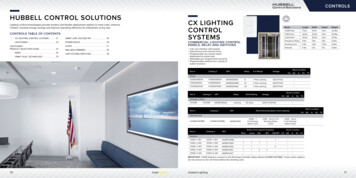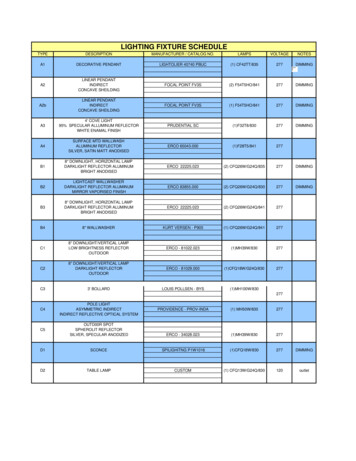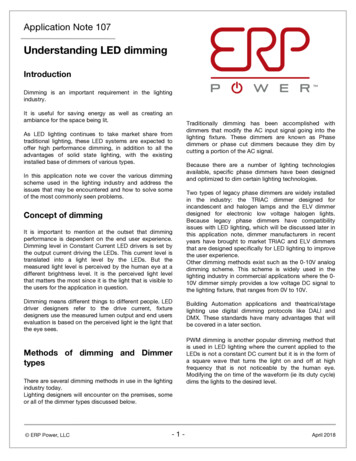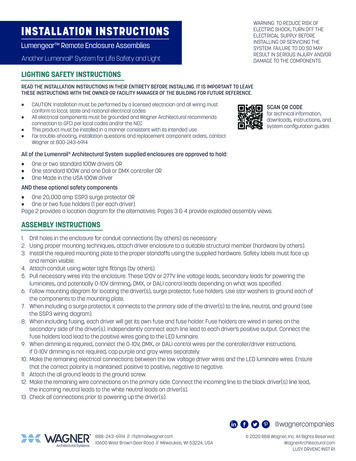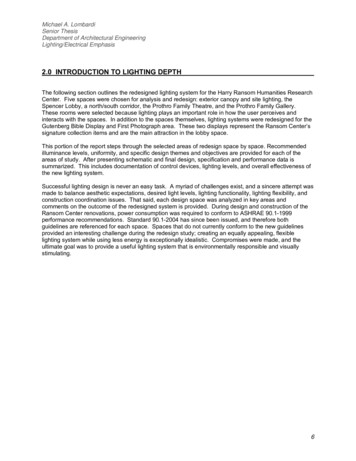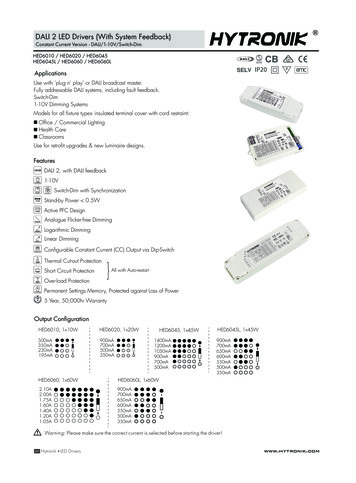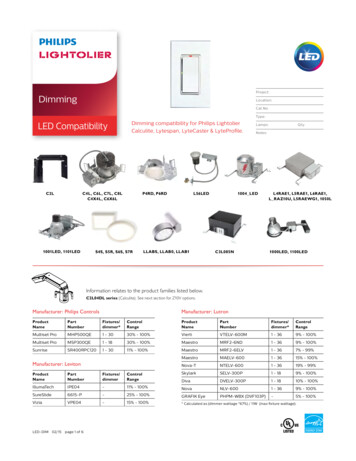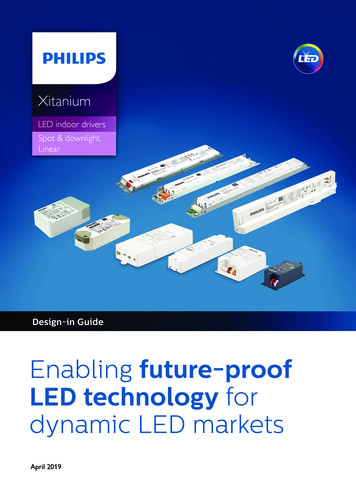
Transcription
COURSE: EE103: DIMMING CONTROLPART 2: DIMMING CONTROLS AND SYSTEMSAUTHORS: STEVE MESH AND CRAIG DILOUIE, LC, CLCPCONTENT: 22
INTRODUCTIONWelcome to Part 2 of EE103: Dimming Control, Dimming Controls andSystems.The first major light source, incandescent lamps, was originally dimmed byrheostats (resistant dimming). In the 1950s and 1960s, dimmers wereinvented that used electronic components. All subsequent major lightsources can be dimmed but require dimmers and/or dimmable drivers/ballasts designed to work with them. LED, today’s most popular commerciallight source, is typically controllable without a significant cost premium ormost compatibility concerns, democratizing dimming applications withinbuildings.The variation in different types of nonresidential dimmers and dimmingsystems has greatly increased, based in part on electronics enabling devicesto communicate and new communication methods, including wireless. Thesetechnological advances allowed manufacturers to create a wide variety ofdimmers that work on a standalone basis or as part of a larger system.This learning module describes this equipment, starting with simple wallboxdimmers and working up to more complex systems.Image courtesy of LightingTutor.com
LEARNING OBJECTIVES Students will be able to apply dimming as a control strategy tobuildings based on an understanding of its availability and how it’simplemented. Students will be able to select the right equipment to satisfy evolvingcommon dimming applications. Students will be able to provision dimming from singular to very largeapplications. Students will be able to discern traditional from modern lighting anddimming systems to make the most appropriate selection for a givenproject.
DIMMING IN TODAY’S BUILDINGSInitially, dimming was primarily used with incandescent lamps, typicallydriven by visual needs such as mood setting. Over time, dimming becameavailable for fluorescent, HID, neon, and cold cathode, which requireddimmable ballasting at a premium cost. As a result, dimming washistorically limited to applications where visual needs was a primaryconcern.This has changed for two reasons. The first is a major technological shift toLED light sources, which are inherently controllable. Currently, the majorityof LED luminaires feature a dimmable driver (usually 0-10VDC) as standardor standard option. The second reason is the evolution of commercialbuilding energy codes to require bilevel switching and more detailed controlactivity during occupancy, such as daylight response, providingopportunities for dimming to reduce lighting use without disruptiveswitching or turning the lights OFF. Developing applications such asdemand response and high-end trim—along with energy codes such asCalifornia Title 24, which requires LED lamps and luminaires to bedimmable from 10-100%—may accelerate the use of dimming.As a result, for the first time, it is quite possible if not likely that dimmingfor energy management has eclipsed dimming for visual needs, and is fastbecoming a staple lighting capability in commercial buildings.Image courtesy of Leviton
WALLBOX DIMMERSWallbox dimmers are simple control devices that are typically mounted in ajunction box on the wall between the power supply and the lighting load.They are typically controlled manually (e.g., rotary knob or slider), thoughthey may be designed to accept commands from other devices (e.g., keypador 3-way).The device either dims the lamps directly as in the case of incandescent/halogen or signals a compatible dimming driver/ballast to dim as in the caseof LED, fluorescent, and HID. Some dimmers are designed to digitallycommunicate with other dimmers and/or with lighting control systems,either wired or wirelessly. Meanwhile, functionality is expanding.As a result, the simple wallbox dimmer has evolved, and simply specifying a“wallbox dimmer” today is typically not sufficient.Images courtesy of Lutron Electronics
WALLBOX DIMMERS: APPLICATIONSWallbox dimmers are desirable anywhere flexibility of light levels is needed.Their use is primarily driven by visual needs in applications such asresidential, classrooms, conference rooms, restaurants, etc. Because LEDluminaire are typically dimmable, however, they can provide flexibility andenergy cost savings wherever local space controls are needed.
WALLBOX DIMMERS: THEORY OF OPERATIONTypically, wallbox dimmers for line-voltage incandescent/halogen lampsemploy the phase-control method, turning the lamps ON and OFF 120 timesper second (based on standard 60 Hz frequency) and “chopping” the ON/OFF cycle to create what is perceived as smooth, continuous dimming. Thelonger the light is OFF versus ON, the lower the output and resulting energyconsumption.The diagrams shown below are examples of forward phase-control, in whichthe dimmer electronics chop the front end of the waveform. Reverse phasecontrol chops the waveform’s trailing edge and is typically used for LED orlow-voltage halogen lamps with drivers/electronic transformers.In an LED, fluorescent, or HID dimming system, the actual power and lightreduction is done by a dimmable driver or ballast designed to accept controlsignals as an input and dim the lamps as an output. The control signal circuitmay be low- or line-voltage. The ballasts are typically wired in parallel sothe load can be controlled in unison.Due to this variation, it is recommended to check with the lamp/luminaireand dimmer manufacturer to verify compatibility between products.Image courtesy of Lutron Electronics
WALLBOX DIMMERS: BASIC MODELThe basic wallbox dimmer is a manual control that enables users to controllight levels. Various configurations are available including linear slides,rotary knobs, and raise/lower buttons. Various types of styling are availableto complement architectural interiors.Most phase-control (line-voltage) wallbox dimmers have what’s called an“air-gap” OFF feature. That is typically evidenced by a click at the bottomend of the range. This physically disconnects the circuit in the same way thata non-dimmable switch does. Alternately, the device may separate dimmingand switching with, say, a slider used to select light level and a switch to turnthe lights OFF and then ON at the last designated light level.Some wallbox dimmers that seem very basic may still have some advancedfunctions. One example is a dimmer with high-end trim; some also have alow-end trim function. Some dimmers even fade between different lightlevels and also allow adjustment of the fade rate.Images courtesy of Lutron Electronics
CONFIGURATIONSWallbox dimmers can be categorized as single-pole, three-way or multilocation. Single-pole dimmers control the lights from a single location.Single-pole switches and dimmers essentially “open” the circuit (to turnlights OFF) or “close” the circuit (to turn lights ON). A dimmer function isadded to chop the waveform and dim lights.Three-way dimmers dim the lights from one location, with connectedthree- and four-way switches added to turn the lights ON to the dimmer levelor OFF from multiple locations.Multilocation dimmers can be used with accessory dimmers for full controlof the lights from an unlimited number of locations. These devicescommunicate control signals, enabling dimming from multiple locations.Images courtesy of Lutron Electronics
WALLBOX DIMMERS/SENSORSA wallbox dimmer can also be combined with an occupancy or vacancysensor. In a wallbox vacancy sensor with a dimming function, a manualswitch is used to turn the lights ON, as well as to act as a manual override(for example turning the lights OFF even if the space is occupied). Thesensor element automatically turns the lights OFF when the space isunoccupied. In a wallbox occupancy sensor, the switch is essentiallyprovided as a manual override, since turning lights ON and OFF are bothautomatic functions.Incorporating a dimmer function into these devices provides an extra level ofcontrol for the occupant. Some of these devices feature the ability to set atime delay, retriggering, hold-OFF function based on input from an integralphotosensor, and more.Image courtesy of Lutron Electronics
WALLBOX DIMMERS: INTEGRATED (PRESET) DIMMERSIntegrated or preset dimmers are programmable dimmers with a bank ofpreset controls. In some cases, these devices have universal circuitry thatallows each dimmer output (channel) to control multiple designated types oflighting loads. Typically, the user can program and then recall multiplelighting scenes for multiple zones by pressing a button or based on aprogrammed schedule. Auxiliary controls such as handheld IR remotes maybe available.Some multi-zone, multi-scene dimmers come in the form of a unified multigang device. This may contain sliders or raise/lower buttons to control lightlevels for two, three, or even more zones of lights. It also incorporates thescene selector buttons, full OFF, and sometimes other buttons as well, suchas a master raise/lower. Often, a single-gang standalone scene selectordevice is offered as a companion product and communicates with the master(multi-gang) device to command lights to dim. You might, for example,locate this remote scene selector device in the finished space and then mountthe master device in a closet to prevent unauthorized access to the dimmersettings.Image courtesy of Lutron Electronics
WALLBOX DIMMERS: INTEGRATED (PRESET) DIMMERSIn a conference room, for example, this system could create unique lightingscenes to support a variety of functions, such as lectures, presentations, slideprojections or meetings.Images courtesy of Lutron Electronics
WALLBOX DIMMERS: NETWORKINGSome wallbox dimmers are designed to respond to commands from otherdevices such as keypads, master control stations, and other wallboxdimmers. The devices may communicate using dedicated low-voltagewiring, power-line carrier wiring, or via wireless signals.
GROUPING WALLBOX DIMMERSMultiple dimmers may be needed for control of multiple lighting zones inthe same space. For this purpose, wallbox dimmers may be co-located intwo- and multi-gang configurations. Dimmers dissipate heat through themetal plate; but this plate may need to be physically altered so that two ormore dimmers can fit into the junction box with a standard multi-gangfaceplate covering all devices.If the dimmers must be spaced similarly to switches, then two- or multi-gangconfigurations are used, which often involves removing part of the heat sink(as shown below). This reduces the capacity (load) the dimmer can control.Image courtesy of Lutron Electronics
POWER PACKSAlso called power extenders or boosters, power packs increase wallboxdimmer capacity to handle larger lighting loads. In this scenario, the dimmersends a signal to the power pack which dims or switches the lights. As aresult, a remotely mounted power pack can handle considerably more loadthan the wallbox dimmer, depending on the product.Some of these power packs are also designed to accept additional inputsfrom other devices such as timeclocks and occupancy and photosensors tocreate a simple integrated system.Images courtesy of Lutron Electronics
ARCHITECTURAL PRESET DIMMING SYSTEMSUnlike wallbox dimmers and power packs, architectural preset dimmingsystems have a centralized dimming panel(s) containing dimmers for controlof multiple zones, typically located in spaces such as electrical closets. Thisallows dimming control for much larger, more complex projects such asballrooms.The dimmers in these panels are commanded by interfaces called controlstations typically installed in the room being controlled. The control stationsends signals to the panel, which actually controls the load. The panel mayaccept inputs from other control devices such as switches, sensors, andtimeclocks.Image courtesy of Wattstopper
ARCHITECTURAL PRESET DIMMING SYSTEMS VS. NETWORKEDLIGHTING CONTROLSCompared to traditional architectural preset dimming systems, networkedlighting control (NLC) systems offer significant advantages and havebecome even more compelling due to the growing predominance ofcontrollable LED lighting. Wiring is simplified, and many systems usewireless communication to establish network connections. Zoning ofluminaires occurs using software, rezoning is simple, integration with othercontrol functionality is simple, and some systems also provide additionalfunctionality such as color tuning.Image courtesy of OSRAM Encelium
CONTROL STATIONSThe control station is the “brain” of the architectural preset dimming systemallowing multizone control, including scene select, recall, and potentiallyscheduling. They install at the wallbox in a 2 gang size, though they do notdirectly control the load but instead generate control signals for lightingcontrol and potentially control other systems such as automated windowshading and HVAC. They allow control of multiple lighting circuits fromone unit, which can be more convenient and visually pleasing than a row ofdimmers on the wall. The interface may feature buttons or an LCDtouchscreen with text and/or graphics.Image courtesy of Lutron Electronics
DIMMING SYSTEMS: DISTRIBUTED PANELS (ROOMCONTROLLERS)Another type of dimming system uses distributed micro panels for smalland/or individual spaces with a digital communication architecture instead ofa centralized panel for larger and/or multiple spaces. These systems, as in theexample shown below, are also commonly referred to as “room controllers,”though they may be connected for larger projects.These devices can only control a limited number of switch legs, which iswhat differentiates them from larger, centralized systems. With thisapproach, the micro panels are distributed close to the loads they control andcan provide switching or dimming of standard analog dimming ballasts orLED drivers—e.g., using the 0-10V protocol.In this executive office, a two-relay dimming room controller is configuredfor automatic-ON to 50%/automatic-OFF operation for the pendantluminaires and manual-ON operation for the whiteboard lighting. Alllighting is dimmable using analog 0-10V LED drivers and digital dimmerswith a four-scene personal remote.Unlike in networked lighting control systems, individual luminaires in theseroom controller systems are not typically addressable. For example, the twoType D luminaires lighting the whiteboard are in the same zone, asdetermined by the wiring from the room controller. They cannot beindividually switched or dimmed.
Image courtesy of Wattstopper
DIGITAL DIMMING BALLASTS FOR FLUORESCENT LAMPSIn the 1990s, standards were developed for digital dimming ballasts forfluorescent lamps. The predominant open-source standard is the DigitalAddressable Lighting Interface (DALI), though a variety of proprietarystandards followed.The method used to dim the lamps wasn’t new, as fluorescent dimmingballasts were available for decades but were limited in application due totheir cost premium. What was new was that each ballast was designed to beaddressable for control individually or as part of a group on a network.Unlike architectural preset dimming systems that were primary designed todim incandescent lamps in hospitality spaces such as ballrooms, networkedlighting control systems controlling fluorescent luminaires are primarilyintended for use in commercial and institutional space types such as offices.Because networked lighting control systems are designed from the outset totake input from devices such as occupancy sensors, photosensors, schedules,and dimmers, early systems that relied on digital dimming ballasts werepredominantly employed to reduce energy usage.Image courtesy of OSRAM
DIGITAL DIMMING DRIVERS FOR LED LAMPS AND LUMINAIRESThe past decade has seen the meteoric rise in the use of LED lamps andluminaires. Similar to fluorescent lamps requiring a ballast, LEDs require adriver to provide the appropriate electrical output on the secondary side tothe LEDs chips on printed circuit boards.Unlike fluorescent ballasts, the majority of LED drivers are dimmable due tohow the market for these light sources developed and the associatedeconomics. Commonly, these LED drivers use an analog dimming signal(e.g., 0-10V), though manufacturers make digital LED drivers as well. Thelatter operates in much the same way that digital fluorescent dimmingballasts work.Another relatively recent development in the lighting industry is that manynetworked lighting control manufacturers now provide preset functions inthe software, enabling programmable and recallable scenes. The systemallows preset functions only where needed while implementing other controlstrategies in other spaces. With these robust features, the latest networkedsystems are more versatile than architectural preset dimming systems.Image courtesy of OSRAM
YOU’RE FINISHEDWell done! You have completed EE103: Dimming Control, Part 2: DimmingControls and Systems. You are also now eligible to take this learningmodule’s comprehension test for credit towards your education goals.
In an LED, fluorescent, or HID dimming system, the actual power and light reduction is done by a dimmable driver or ballast designed to accept control signals as an input and dim the lamps as an output. The control signal circuit may be low- or line-voltage. The ballasts are typically wired in parallel
